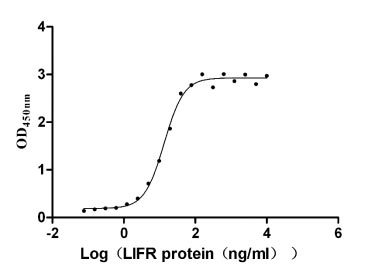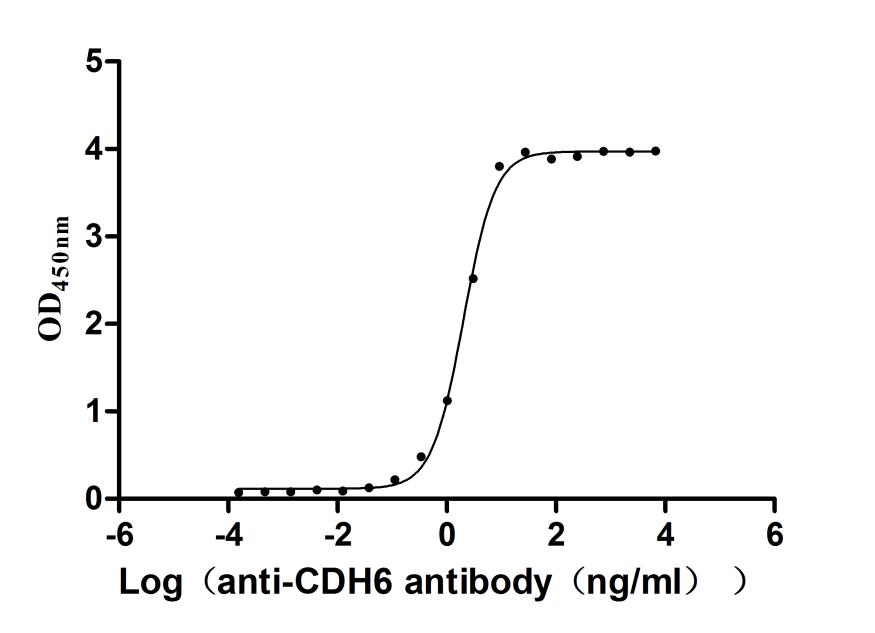Recombinant Human Gamma-secretase subunit APH-1A (APH1a)
-
货号:CSB-CF853390HU
-
规格:¥9720
-
图片:
-
其他:
产品详情
-
纯度:Greater than 90% as determined by SDS-PAGE.
-
基因名:
-
Uniprot No.:
-
别名:APH1A; PSF; CGI-78; UNQ579/PRO1141; Gamma-secretase subunit APH-1A; APH-1a; Aph-1alpha; Presenilin-stabilization factor
-
种属:Homo sapiens(Human)
-
蛋白长度:Full Length of Isoform 2
-
来源:in vitro E.coli expression system
-
分子量:42.9kDa
-
表达区域:1-247aa
-
氨基酸序列MGAAVFFGCTFVAFGPAFALFLITVAGDPLRVIILVAGAFFWLVSLLLASVVWFILVHVTDRSDARLQYGLLIFGAAVSVLLQEVFRFAYYKLLKKADEGLASLSEDGRSPISIRQMAYVSGLSFGIISGVFSVINILADALGPGVVGIHGDSPYYFLTSAFLTAAIILLHTFWGVVFFDACERRRYWALGLVVGSHLLTSGLTFLNPWYEASLLPIYAVTVSMGLWAFITAGGSLRSIQRSLLCKD
Note: The complete sequence including tag sequence, target protein sequence and linker sequence could be provided upon request. -
蛋白标签:N-terminal 6xHis-SUMO-tagged
-
产品提供形式:Liquid or Lyophilized powder
Note: We will preferentially ship the format that we have in stock, however, if you have any special requirement for the format, please remark your requirement when placing the order, we will prepare according to your demand. -
缓冲液:Lyophilized from Tris/PBS-based buffer, 6% Trehalose, pH 8.0
-
储存条件:Store at -20°C/-80°C upon receipt, aliquoting is necessary for mutiple use. Avoid repeated freeze-thaw cycles.
-
保质期:The shelf life is related to many factors, storage state, buffer ingredients, storage temperature and the stability of the protein itself.
Generally, the shelf life of liquid form is 6 months at -20°C/-80°C. The shelf life of lyophilized form is 12 months at -20°C/-80°C. -
货期:Basically, we can dispatch the products out in 1-3 working days after receiving your orders. Delivery time may differ from different purchasing way or location, please kindly consult your local distributors for specific delivery time.Note: All of our proteins are default shipped with normal blue ice packs, if you request to ship with dry ice, please communicate with us in advance and extra fees will be charged.
-
注意事项:Repeated freezing and thawing is not recommended. Store working aliquots at 4°C for up to one week.
-
Datasheet & COA:Please contact us to get it.
相关产品
靶点详情
-
功能:Non-catalytic subunit of the gamma-secretase complex, an endoprotease complex that catalyzes the intramembrane cleavage of integral membrane proteins such as Notch receptors and APP (amyloid-beta precursor protein). Required for normal gamma-secretase assembly. The gamma-secretase complex plays a role in Notch and Wnt signaling cascades and regulation of downstream processes via its role in processing key regulatory proteins, and by regulating cytosolic CTNNB1 levels.
-
基因功能参考文献:
- Using purified PSEN1/Aph1A gamma-secretase and the APPC99-3XFLAG substrate, s show that substrate shortening progressively destabilizes the consecutive enzyme-substrate complexes that characterize the sequential gamma-secretase processing of APP; present a unifying model for how PSEN or APP mutations enhance amyloidogenic Abeta production, suggests that environmental factors may increase Alzheimer's Disease risk. PMID: 28753424
- Data show that presenilin 1 (PS1)/anterior-pharynx-defective protein 1 (Aph1b), presenilin 2 (PS2)/Aph1aL, PS2/Aph1aS and PS2/anterior pharynx defective 1 homolog B (Aph1b) gamma-secretase produced amyloid beta peptide (Abeta) with a higher Abeta42+Abeta43-to-Abeta40 (Abeta42(43)/Abeta40) ratio than the other gamma-secretases. PMID: 27608597
- Data show that presenilin 1 (PS1)-containing gamma-secretase complexes were targeted to the plasma membrane, whereas presenilin 2 (PS2)-containing ones were addressed to the trans-Golgi network, to recycling endosomes. PMID: 27059953
- No statistically significant difference was detected either in APOE or APH-1a polymorphisms, not suggesting a strong susceptibility to the development of Alzheimer disease. PMID: 26738354
- A loss of PS/gamma-secretase function to cleave Abeta42(43) may initiate Alzheimer's disease. PMID: 23291095
- We demonstrate that extending the transmembrane domain of the amyloid precursor protein-derived C99 substrate in proximity to the cytosolic face strongly influences gamma-secretase cleavage specificity. PMID: 23253155
- The -980C/G polymorphism in APH-1A promoter confers risk of Alzheimer's disease PMID: 21443683
- Coexpression of wild-type or S-palmitoylation-deficient APH1aL and nicastrin leads to marked stabilization of transgenic presenilin 1 in the brains of double-transgenic mice. PMID: 21123562
- Endogenous Aph-1a and its proteolytic fragment have unique properties for cleavage control that may have implications for gamma-secretase regulation and intracellular distribution. PMID: 20674680
- Co-overexpression of presenilin-1 or APH-1 abrogated gamma-secretase inhibition probably through prevention of the incorporation of CRB2 into the gamma-secretase complex PMID: 20299451
- Aph-1 associates directly with full-length and C-terminal fragments of gamma-secretase substrates PMID: 20145246
- APH-1 binds to presenilins and nicastrin and may play a role in maturation of presenilin-nicastrin complexes PMID: 12471034
- Expression of APH-1A increases amyloid beta peptide levels and gamma-secretase activity. PMID: 12763021
- APH-1 and the gamma-secretase complex bind to the transmembrane domain region of nicastrin PMID: 12917438
- Six different polymorphisms have been determined but the polymorphisms in APH-1a/b coding regions are not linked to higher risk for Alzheimer disease in an Italian population. PMID: 12972157
- APH-1 can be processed by several endoproteolytic events and generates a stable C-terminal fragment that associates with nicastrin PMID: 14593096
- conserved transmembrane Gly122, Gly126, and Gly130 in the fourth transmembrane region of APH-1a are part of the membrane helix-helix interaction GXXXG motif and are essential for the stable association of APH-1aL with presenilin, nicastrin, and PEN-2 PMID: 14627705
- Only the combined overexpression of presenilin 1 and nicastrin together with APH-1a G122D facilitated the formation of a fully active gamma-secretase complex PMID: 15210705
- both APH-1a splice forms and APH-1b are expressed in peripheral and neuronal cells. APH-1aS, APH-1aL, and APH-1b form separate, proteolytically active gamma-secretase complexes containing either one of the two presenilins. PMID: 15286082
- knock down of APH-1a, but not APH-1b, resulted in impaired maturation of nicastrin and reduced expression of presenilin 1, presenilin 2, and PEN-2 proteins PMID: 15629423
- These results collectively indicate that the three forms of APH-1 can replace each other in presenilin (PS) complexes and that the transmembrane GxxxG region is essential for the stability of the APH-1 protein as well as the assembly of PS complexes. PMID: 16757808
- Over-expression of APH-1 and inhibition of proteasomal APH-1 degradation facilitated gamma-secretase cleavage of APP to generate Abeta. Thus,degradation of APH-1 protein is mediated by the ubiquitin-proteasome pathway. PMID: 17059559
- analysis of model of the gamma-secretase complex subunit architecture and demonstration of the close proximity of the C-terminal fragment of presenilin with APH-1 PMID: 18801744
- that there is an association between the -980C/G polymorphism in the APH-1a promoter region and the development of sporadic Alzheimer's disease PMID: 19368855
- the conserved transmembrane histidine residues contribute to APH1 function and can affect presenilin catalytic activity PMID: 19369254
显示更多
收起更多
-
亚细胞定位:Endoplasmic reticulum membrane; Multi-pass membrane protein. Golgi apparatus, Golgi stack membrane; Multi-pass membrane protein.
-
蛋白家族:APH-1 family
-
组织特异性:Widely expressed. Expressed in leukocytes, lung, placenta, small intestine, liver, kidney, spleen thymus, skeletal muscle, heart and brain. Isoform 1 and isoform 2 are nearly expressed at the same level.
-
数据库链接:
HGNC: 29509
OMIM: 607629
KEGG: hsa:51107
STRING: 9606.ENSP00000358105
UniGene: Hs.108408
Most popular with customers
-
Recombinant Human Leukemia inhibitory factor receptor (LIFR), partial (Active)
Express system: Mammalian cell
Species: Homo sapiens (Human)
-
Recombinant Macaca fascicularis Delta-like protein 3 (DLL3), partial (Active)
Express system: Mammalian cell
Species: Macaca fascicularis (Crab-eating macaque) (Cynomolgus monkey)
-
Recombinant Human Nectin-4 (NECTIN4), partial (Active)
Express system: Mammalian cell
Species: Homo sapiens (Human)
-
Recombinant Macaca fascicularis Claudin (CLDN18)-VLPs (Active)
Express system: Mammalian cell
Species: Macaca fascicularis (Crab-eating macaque) (Cynomolgus monkey)
-
Recombinant Human Interleukin-17A (IL17A) (T26A) (Active)
Express system: Baculovirus
Species: Homo sapiens (Human)
-
Recombinant Human Interleukin-2 (IL2) (Active)
Express system: Mammalian cell
Species: Homo sapiens (Human)
-
Recombinant Mouse Cadherin-6(Cdh6),partial (Active)
Express system: Mammalian cell
Species: Mus musculus (Mouse)







-AC1.jpg)












